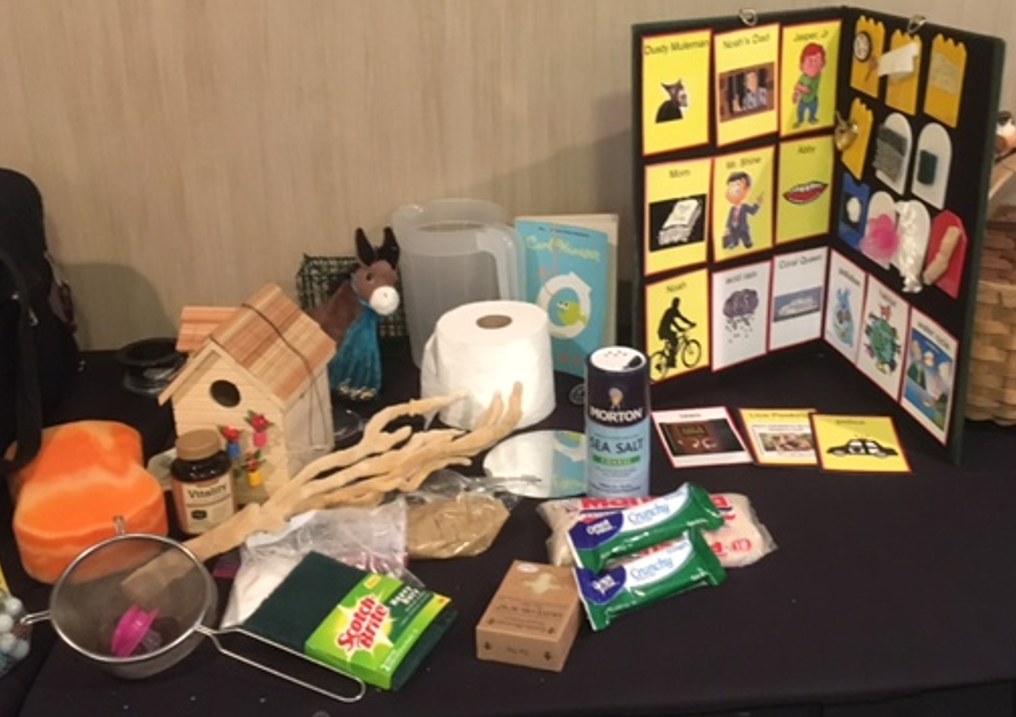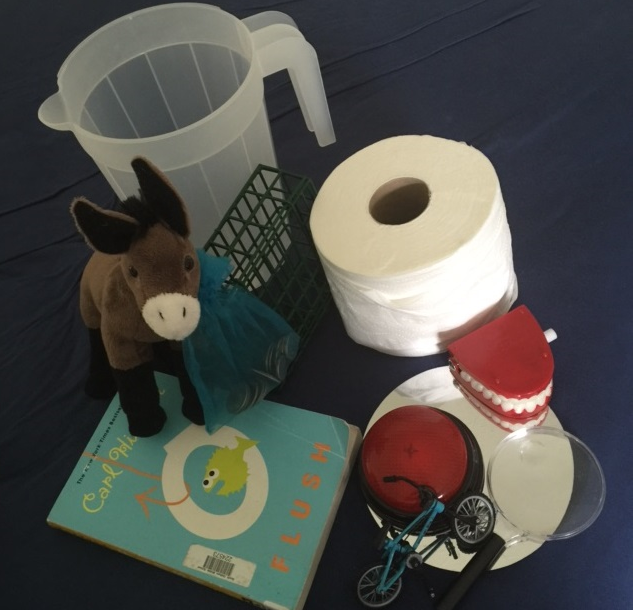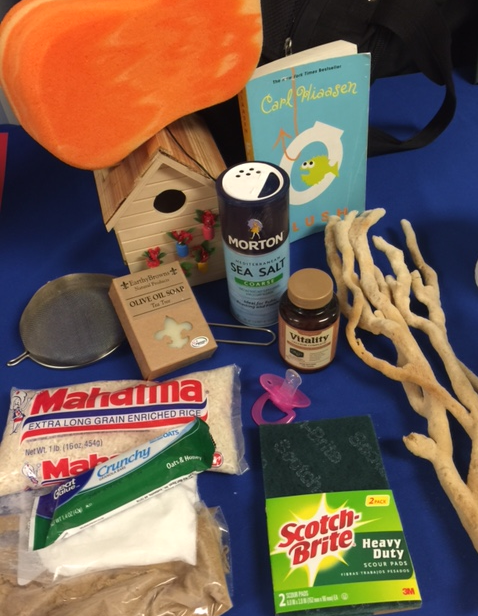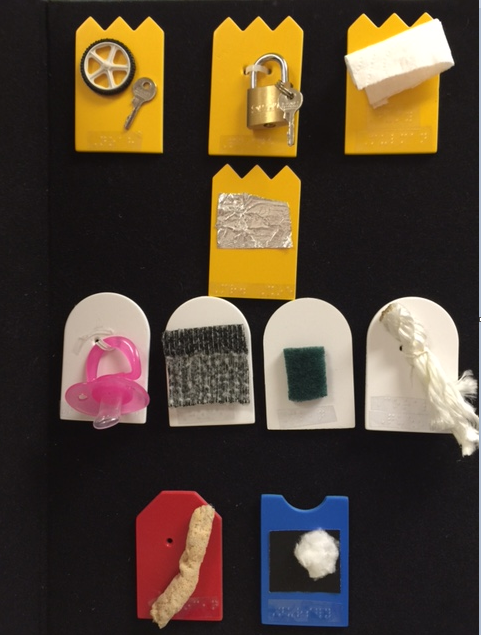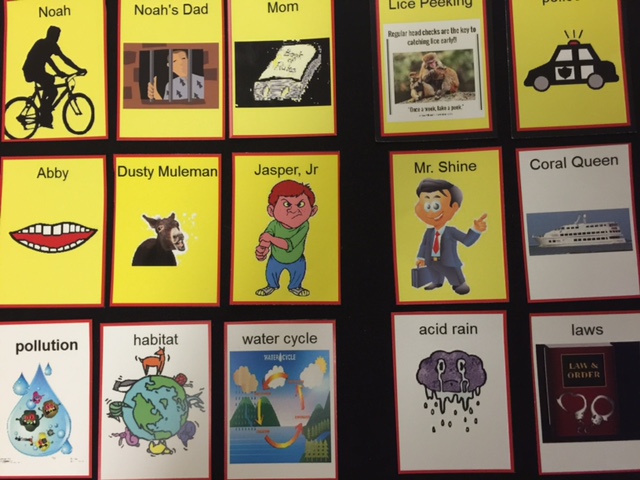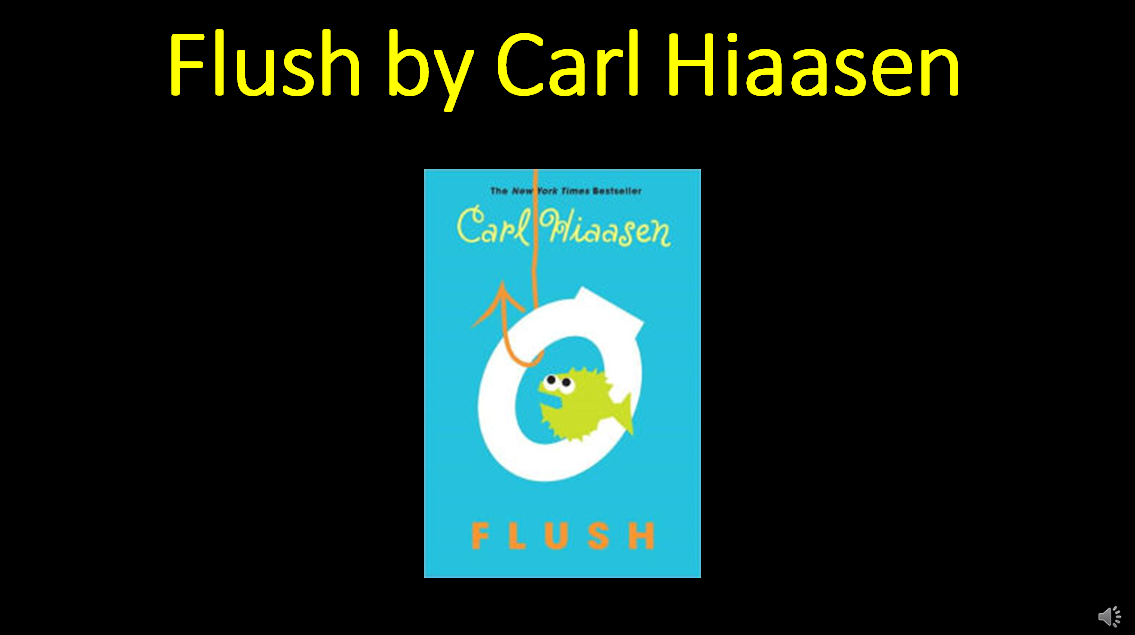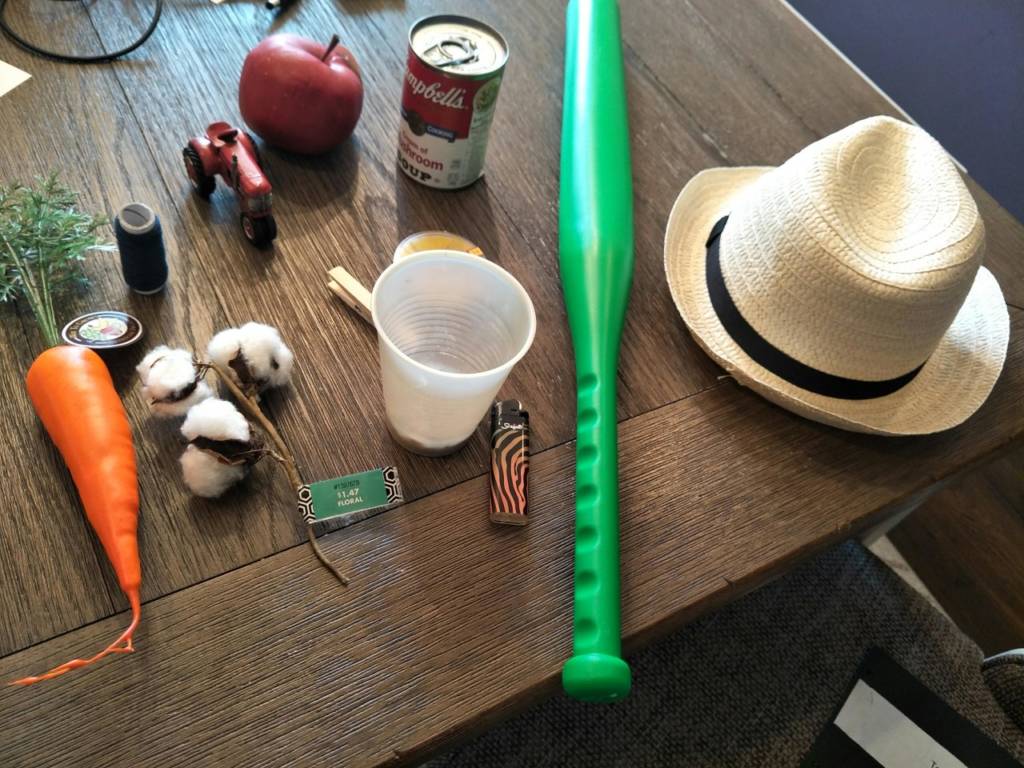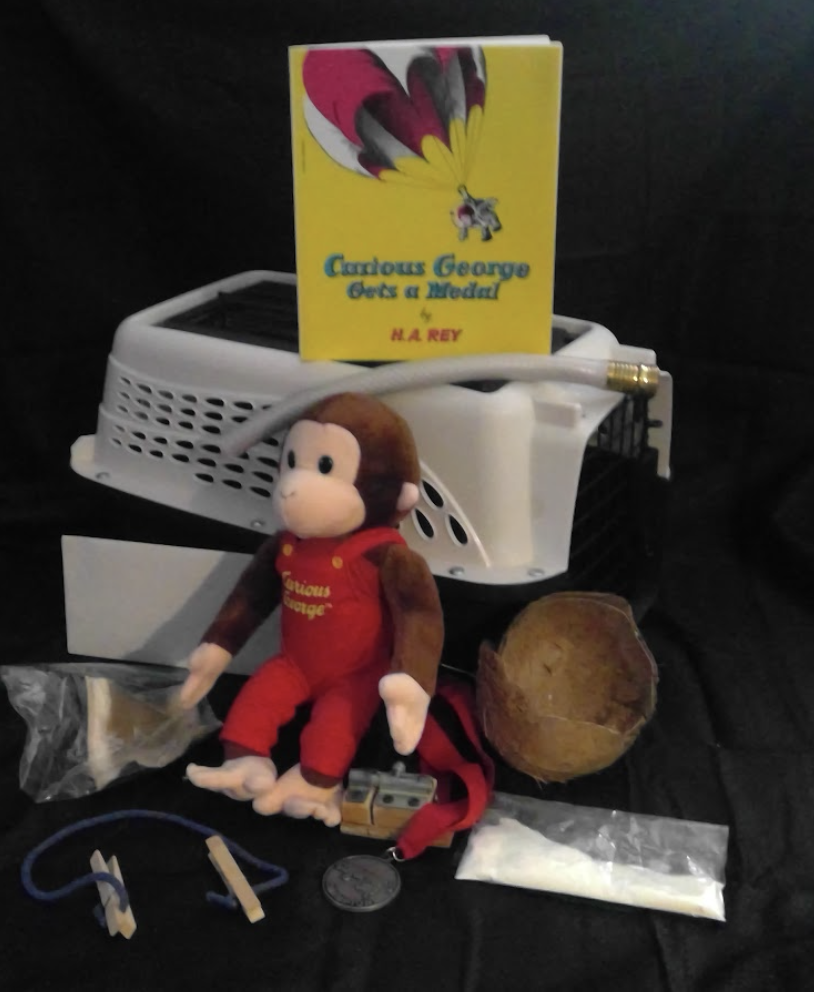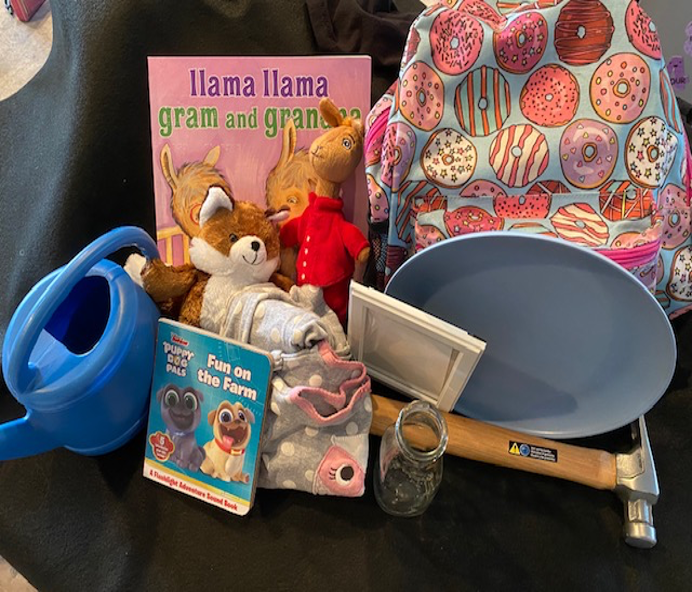As part of the graduate coursework for Visual Impairments and Multiple Disabilities in the Teacher Preparation Program in Visual Impairments at the University of Kentucky, students were asked to complete four projects: Story Box, Picture Communication Symbols for Story Box, Tactile Communication Symbols, and Talking Book Project.
We are sharing them on Paths to Literacy and hope that others will use them! Please add your comments at the bottom of the page. This project is based on Flush by Carl Hiaasen.
Introduction
I chose Flush by Carl Hiaasen because it can engage students across a broad range of ages and reading ability (DRA level is 60 and Lexile Level is 830) while addressing multiple standards, cutting concepts, and engineering practices addressed in the NGSS (Next Generation Science Standards).
Story Box
Flush lent itself well to the storybox concept by offering opportunities to not only incorporate tactile and picture symbols with which to identify key characters, but also allowing for incorporating tactile and picture symbols to represent key science vocabulary concepts.
- Materials: I used a suitcase to put all of my tactile symbols in and, thus, used the suitcase as an additional tactile symbol. I used a Velcro trifold on which to adhere my picture symbol cards and tactile symbols cards.
- Procedure: House all story box items in a suitcase which represents a key science concept explained below and I would implement the following six ideas:
Six Ideas for Implementation of this story box would be:
- Alternate reading aloud or having students read independently during the beginning of biology during the unit which covers the interdependence of ecosystems.
- Have students predict why specific items might represent a character or a concept.
- Have students come up with other items that could represent concepts or characters in the book.
- Have students explain what would happen in an ecosystem if a boat dumped its waste into natural habitats. Include dialogue about why laws of “no dumping” exist.
- Have students apply the Engineering Process to the plan that Noah, Abby, Shelly, and Lice devised to catch Dusty Muleman in the act of breaking the law
- I will also pull up my talking book at specific moments and incorporate relevant sounds that have to do with the book. For example, ocean waves coming to and leaving from shore, a boat exploding, a toilet flushing, and a prison cell door closing.
Explanation of Items in Story Box and What Each Represents:
- Noah: Miniature Bicycle Noah is the main character in the story and uses his bike to get everywhere he needs to go to solve a mystery for his dad while his mother is working. The key is there to represent the fact that Noah is trying to find the key to get his dad out of jail.
- Coral Queen: The Coral Queen is the name of a gambling boat owned by Dusty Muleman. The toilet paper represents the waste Dusty’s boat is dumping into the ocean into the ocean without letting it be filtered or treated.
- Dusty Muleman: Dusty is the antagonist in the story and the villain dumping waste into the rivers and ocean around Key West. The author likely names him Dusty Muleman to represent his old ideas about ecosystems and stubbornness about following the law because he prefers to make and save money. The mule stuffed animal with a collar and a bag of coins attached represents Dusty.
- Noah’s Dad, Paine Underwood: Noah’s Dad is in jail for breaking the law because he sank a boat that was polluting the environment. Paine is aptly named “Paine” because he keeps keeping himself in painful predicaments. The suet cage represents his jail cell. The lock can only be opened by Noah’s key.
- Abby Underwood, Noah’s sister: She had a bad habit as a toddler of biting people and during the climax of the book she bites one of the antagonists. She is represented by a fake set of teeth.
- Mr. Shine: Paine’s lawyer is aptly named Mr. Shine because he is shining light on the truth. He is represented by a mirror.
- Lice Peeking: Someone who used to work for Dusty and Noah needs his help. He is rough around the edges yet very helpful. He is represented by a kitchen scrubber.
- Shelly: Lice Peeking’s girlfriend and she used to bartend on the Coral Queen. As the story progresses she helps Noah get evidence that Dusty really is dumping raw waste by pouring a pitcher full of pink food coloring into the toilets on the boat. She is represented by a plastic pitcher.
- Police: The police are involved frequently in this story and every time they are called on they can be represented by this button that makes a police siren sound.
- The Island Examiner Reporter Miles Ulmatt: He is charged with looking at evidence and reporting to key west what is happened to the Coral Queen. He is represented by a magnifying glass.
- Bag of Sand: Sand is tiny pieces of rock that have been eroded from multiple larger mountains and rocks around the world.it is found at the bottoms of oceans, many rivers, and is especially prevalent on the coast.
- Strainer: Wetlands filter our water
- Birdhouse: Green leafy trees are found in wetlands and you will not find birds where there are no trees.
- Many of the U.S. breeding bird populations– including ducks, geese, woodpeckers, hawks, wading birds and many song-birds– feed, nest and raise their young in wetlands. https://www.epa.gov/wetlands/why-are-wetlands-important
- Piece of Coral: Healthy coral reefs are among the most biologically diverse and economically valuable ecosystems on earth, providing valuable and vital ecosystem services. Coral ecosystems are a source of food for millions; protect coastlines from storms and erosion; provide habitat, spawning and nursery grounds for economically important fish species; provide jobs and income to local economies from fishing, recreation, and tourism; are a source of new medicines, and are hotspots of marine biodiversity.
- Granola Bar: Wetlands provide a snack for many animals.
- Vitamins: Wetlands and coral reefs are where animals get their vitamins from
- Pacifier: Wetlands are a “nursery” for newborn animals
- Suitcase: wetlands are a hotel for migrating birds
- When winter sets in across the northern hemisphere, it triggers the most extraordinary mass movement of any living creature on Earth – the annual migration of countless birds over vast distances. The world’s wetlands offer a welcome pitstop, offering protection and food before the birds continue on to their final destination.
- Bag of rice, Bag of sugar, Bag of salt: Wetlands grow 70% of our food supply — rice, seafood, cranberries, bananas. Salt is processed from marshy area and sugar is made from cane that can only be grown in wetlands.
- Rice is the staple diet of nearly 3 billion people: Half the world’s population. It is grown in wetlands across Asia and west Africa, and in the United States. Almost as important is sago palm, which provides starch from which sago flour is made. And palms from the wetlands of Africa yield valuable oils for cooking and soap making.
- Sponge: Wetlands absorb the force of strong winds from hurricanes and storms. Wetlands function as natural sponges that trap and slowly release surface water, rain, snowmelt, groundwater and flood waters.
Link that explains value and functions of wetlands: https://www.epa.gov/wetlands/why-are-wetlands-important
Tactile Symbols
What symbols did you choose and why?
Many of these symbols duplicate my thinking for the storybox. There are as follows:
- Noah, the main character is represented by a bike wheel and key. The bike wheel because he bikes everywhere and the key because he is the key to getting his father freed from jail.
- Noah’s Father Paine Underwood, lock and key because he is locked in jail.
- Dusty Muleman, the antagonist in the story is represented by a small piece of toilet paper because he is dumping human waste in the ocean.
- Mr. Shine, the lawyer is represented by a small piece of aluminum foil because it is shiny.
- Wetlands as an animal incubator is represented by a pacifier
- The setting of the book is Noah’s home, which is represented by a minture blanket made from cutting up an old sock
- Kitchen Scrubber represents wetlands as a filter that clean water
- Rope represents the Coral Queen because cutting the rope is how Noah’s dad sank it.
- Coral represents the ocean
- Time is represented by night because noah did most of his investigating at night-darkness and a moon
How would you use these when reading the story?
I would pass them out and have students hold them while being read to and then call out when their symbol is being talked about or when the characters are involved with their symbol.
Picture Symbols
What symbols did you choose and why?
Most of these symbols are self explanatory, reference the above mentioned reasons, or were copied from the internet images about the movie made about the book.
Ten Questions that Could be Answered Using the Picture Communications Symbols for Story Box
- How can pollution in the ocean hurt animals in the ocean if it doesn’t touch them?
- How can the pollution in the ocean also impact land habitats?
- Noah’s dad was just trying to stop water pollution, why was he put in jail?
- How did Abby fight away the criminals?
- Who is the person who doesn’t care about the ocean and wants to save money for his gambling boat instead?
- Who is the main character in the story and who is he trying to rescue?
- Who helped Noah get evidence against Dusty Muleman?
- What was the name of Dusty Muleman’s boat/
- Who was against Noah’s dad, Paine underwood, sinking Dusty Muleman’s boat?
- Who gave Noah a black eye?

